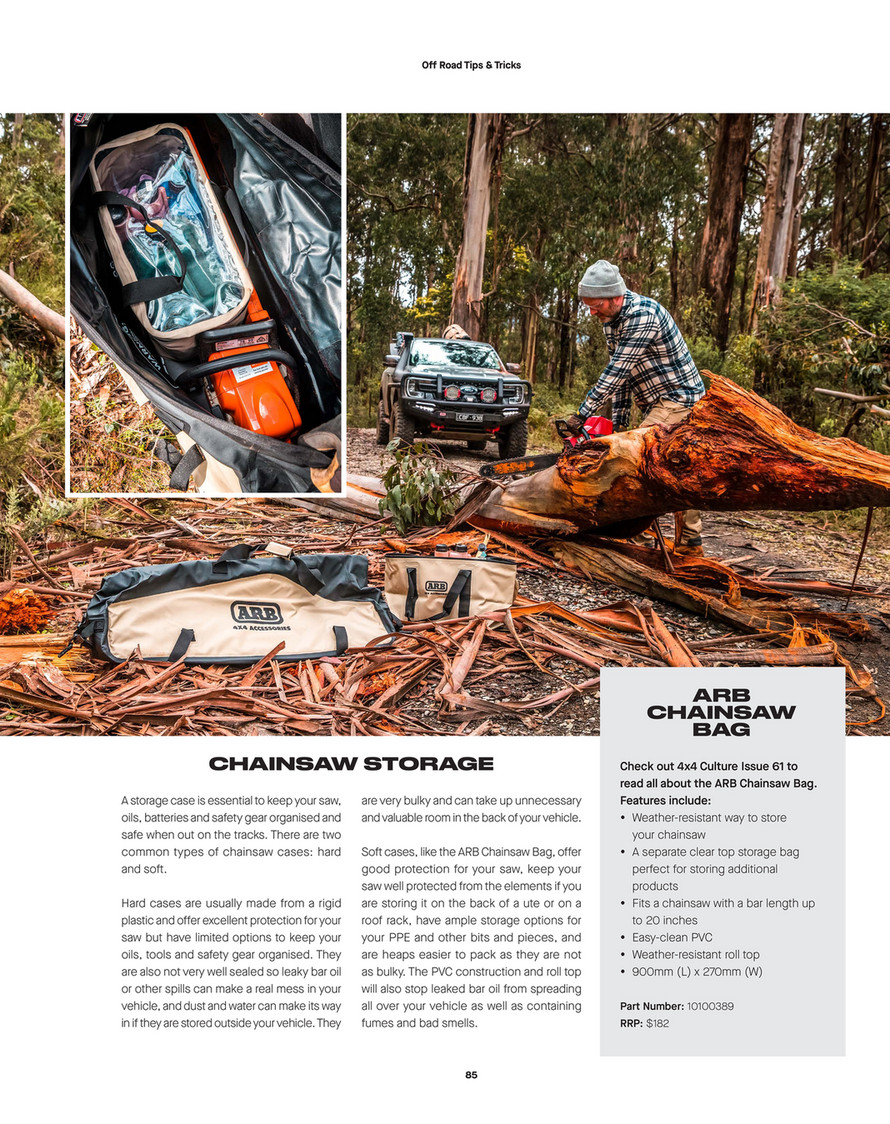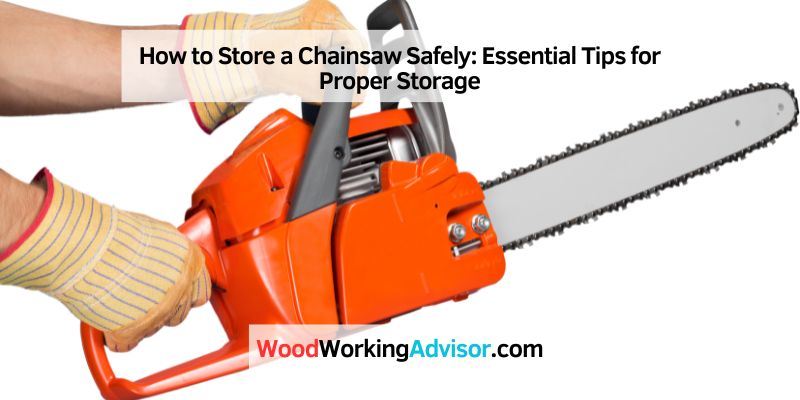To store a chainsaw, clean it thoroughly, drain the fuel tank and bar oil reservoir, remove the chain, and store it in a dry, secure place. Chainsaws should be stored away from moisture, and heat sources, and readily accessible to children or unauthorized individuals.
Additionally, periodic maintenance and inspection are crucial to ensure that the chainsaw remains in good working condition and is ready for use when needed. Proper storage of a chainsaw promotes its longevity and reduces the risk of accidents or damage.
Remember to follow the manufacturer’s guidelines for specific storage instructions based on the type and model of the chainsaw you own.

Credit: view.publitas.com
Choosing The Right Location
When it comes to storing your chainsaw, choosing the right location is crucial to ensure its longevity and performance. Following simple guidelines can help keep your chainsaw in prime condition, ready for whenever you need it. Here are some key factors to consider when selecting a suitable storage location:
Ventilated Area
Avoid storing your chainsaw in a closed or cramped space as this can lead to a build-up of fumes and heat. Instead, opt for a well-ventilated area that allows proper airflow. A well-ventilated location not only reduces the risk of gas accumulation but also helps prevent rust and corrosion by keeping moisture at bay.
Dry And Protected From Elements
Keeping your chainsaw away from the elements is essential in safeguarding it from potential damage. Moisture and exposure to rain or snow can cause rust on metal parts, while excessive sunlight can fade and deteriorate plastic components. Find a storage area that is dry, such as a shed or garage, and ensure your chainsaw is shielded from direct contact with water or sunlight.
Cleaning And Maintenance
Proper cleaning and maintenance are essential steps to keep your chainsaw in top-notch condition. By taking the time to clean and inspect your chainsaw regularly, you can extend its lifespan and ensure optimal performance. In this section, we will cover two crucial aspects of chainsaw maintenance: removing residual fuel and inspecting for wear and tear.
Removing Residual Fuel
Before storing your chainsaw, it’s crucial to drain any remaining fuel from the tank. This step helps prevent the fuel from deteriorating and clogging the carburetor, which can lead to starting issues. Follow these simple steps to remove the residual fuel:
- First, make sure the chainsaw is turned off and cool to the touch.
- Locate the fuel tank cap, usually positioned on the top of the chainsaw.
- Using a suitable tool, such as a flathead screwdriver, carefully loosen the fuel tank cap.
- Slowly tilt the chainsaw, allowing the leftover fuel to drain into an approved container.
- Once the fuel has completely drained, securely tighten the fuel tank cap to prevent leaks.
By removing the residual fuel, you minimize the risk of fuel-related issues and ensure the chainsaw’s overall performance remains unaffected.
Inspecting For Wear And Tear
Regular inspections play a vital role in identifying potential problems and addressing them promptly. Take the time to inspect your chainsaw for any signs of wear and tear using the following guidelines:
- Start by visually examining the chain, guide bar, and sprocket for any visible damage.
- Check for any loose or missing screws, bolts, or nuts that may need tightening or replacing.
- Inspect the air filter and clean or replace it if necessary. A clogged air filter can hinder performance.
- Examine the spark plug for signs of wear or carbon buildup. Replace if needed.
- Ensure the chain brake is functioning correctly by engaging and disengaging it a few times.
Regular inspections not only help prevent unexpected malfunctions but also allow you to address minor issues before they escalate into more significant problems.
Proper Disassembly
To ensure proper storage of your chainsaw and to maintain its longevity, it is important to disassemble it correctly. Proper disassembly involves removing the chain and dismantling additional components. Here’s how you can do that:
Removing The Chain
Start by disconnecting the spark plug to prevent any accidental ignition. Use a screwdriver to loosen the tensioning screw, and then carefully remove the chain from the guide bar. Clean the chain using a degreaser, dry it thoroughly, and then store it in a container with a light coating of oil to prevent rust.
Dismantling Additional Components
Next, remove the guide bar and clean it with a brush to remove any debris and sawdust. Inspect the guide bar for any signs of wear and tear, and apply a thin layer of bar oil to prevent corrosion. Additionally, detach the air filter cover and clean the air filter, ensuring it is completely dry before reinstallation.
Safe Storage Equipment
Ensure safe storage for your chainsaw by using dedicated equipment. Properly store the chainsaw in a dry, secure area away from children and unauthorized users. To prevent accidents, use a chainsaw case or a wall-mount rack, and always remove the chain before storing.
Use Of Chain Guards
Using chain guards is an essential safety measure when it comes to storing your chainsaw. These guards are specifically designed to shield the chain and bar, protecting them from damage and preventing any accidental injuries. They come in various sizes and materials, so choose one that fits your chainsaw perfectly. Chain guards are easy to install and remove, providing an extra layer of protection from dust, moisture, and other elements that could potentially harm your chainsaw while in storage.
Storage In Protective Cases
Another excellent option for safe chainsaw storage is investing in a protective case. These cases are specially designed to provide maximum security and protection to your chainsaw. Made from durable materials such as hard plastic or metal, they offer resistance against impacts, shocks, and external elements. Protective cases usually feature secure locks, ensuring that your chainsaw remains safely stored and inaccessible to unauthorized individuals.
When choosing a protective case, opt for one that is specifically designed for your chainsaw’s model and size. This ensures a snug fit and optimal protection. Some cases even have compartments to store additional tools, accessories, or maintenance equipment.
Table: Comparison Between Chain Guards And Protective Cases
| Chain Guards | Protective Cases |
|---|---|
| Easy to install and remove. | Secure locks for enhanced protection. |
| Shields chainsaw from dust and moisture. | Durable materials offer resistance against impacts. |
| Provides extra protection from accidental injuries. | Designed for specific chainsaw models and sizes. |
Whether you choose to use chain guards or a protective case, both options offer excellent protection for your chainsaw during storage. Consider your specific needs and requirements to determine which method of safe storage equipment is best suited for you.
Periodic Inspection
Periodic inspection is an essential part of properly maintaining your chainsaw. Regularly checking and inspecting various components of your chainsaw can help identify any potential issues or problems before they worsen and affect the performance or safety of the tool. In this section, we will discuss two crucial aspects of the periodic inspection process:
Regular Lubrication
Proper lubrication is vital for the smooth functioning of your chainsaw. Before you store your chainsaw, ensure that all the necessary parts are adequately lubricated to prevent any corrosion or damage during the storage period. Refer to your chainsaw’s user manual for specific instructions regarding lubrication points and the type of lubricant to use. Additionally, remember that over-lubrication can also negatively impact the chainsaw’s performance, so be cautious and follow the recommended guidelines.
Here are a few steps to help you perform regular lubrication:
- Start by cleaning the guide bar and the chain thoroughly to remove debris and excess oil.
- Apply the recommended lubricating oil to the chain, ensuring that all its parts are adequately covered.
- After lubricating the chain, rotate it manually to distribute the oil evenly.
Checking For Corrosion
Corrosion can significantly affect the longevity and performance of your chainsaw. It can occur due to exposure to moisture or prolonged storage without proper maintenance. Regularly checking for corrosion is crucial to prevent potential damage and ensure the chainsaw’s functionality.
Here’s how you can check for corrosion:
- Inspect the guide bar, chain, and other metal parts for any signs of rust or corrosion.
- If you notice any corrosion, take immediate action to remove it. Use a wire brush or sandpaper to gently scrub away the rust.
- Once the corrosion is removed, apply a rust inhibitor or lubricating oil on the affected areas for added protection.
By incorporating regular lubrication and checking for corrosion into your periodic inspection routine, you can help extend the lifespan of your chainsaw and ensure its optimal performance when you need it.

Credit: www.stihlusa.com
Frequently Asked Questions For How To Store A Chainsaw
What Is The Best Way To Store A Chainsaw?
To store a chainsaw properly:
1. Clean it thoroughly after each use to remove debris and oil.
2. Empty the fuel tank and run the engine until it stops for safety.
3. Store it in a dry and cool place, away from direct sunlight and extreme temperatures.
4. Hang it on a wall or use a chainsaw case for secure storage.
5. Regularly inspect and maintain the chainsaw to ensure proper functioning.
Should A Chainsaw Be Stored On Its Side?
No, a chainsaw should not be stored on its side. It is best to store it in an upright position to prevent any oil leaks and ensure proper functioning.
Should You Run A Chainsaw Dry Before Storing?
Before storing, it’s essential to run your chainsaw dry. This helps prevent corrosion and keeps the engine from being damaged.
How Do You Store A Chainsaw So It Doesn’t Leak Bar Oil?
To store a chainsaw without oil leakage, follow these steps:
1. Clean the chain and bar thoroughly.
2. Empty the oil reservoir.
3. Keep the chainsaw upright in a dry and cool place.
4. Place the chainsaw in a plastic bag or wrap it in a cloth.
5. Store it away from direct sunlight or extreme temperatures.
Conclusion
Proper chainsaw storage is essential in maintaining its functionality and prolonging its lifespan. By following these tips, you can ensure that your chainsaw remains in top condition and ready for use whenever you need it. From cleaning and oiling to choosing the right storage location, taking care of your chainsaw will save you time and money in the long run.


